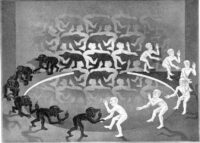The Chinese Taoist Yin-Yang symbol wordlessly conveys the deepest truth of each moment: that existence is not static but dynamic and the forces of creation and destruction carry the seeds of their opposite. The dynamic quality is represented by one black and one white teardrop-shaped intersecting “swirls” which act as reversible “figure/ground” shapes; each swirl’s shape within the enclosed circular form of the symbol creates its opposite’s shape. The forces of creation and destruction are conveyed using a reverse colored dot at the center of each swirl. If one imaginatively animates the symbol, the swirls appear to chase each other, and simultaneously the dot within each grows and reverses the color of each swirl into its opposite. Thus a simple iconic symbol silently conveys what requires well over 100 words to explain.
Sir Issac Newton expressed much the same idea in his Third Law of Motion: “For every action there is an opposite and equal reaction.” He was speaking of the effects of physical force on bodies in motion or at rest, but he might just as well have been describing an element of Taoist thought. Creation and destruction always walk hand-in-hand.
Ideas are no different; each new idea makes an old one obsolete while at the same time creating the potential for its own replacement. A new argument simultaneously creates its counter-argument; if this were not so there would be no new arguments at all. Often, a new argument employs elements of the old to make its case. In this way, new ideas retrieve old ideas. Finally, each new idea turns on its head and results in an element of reversal. And this process, by extension, also applies to the physical outcomes of ideas such as tools and technology.
Thus the auto made the horse and buggy obsolete, but retained animal names like “Mustang” and named its energy “horsepower.” Now the internal combustion auto is yielding to electric vehicles and making its current form obsolete. The enhanced speed of motorized transport engendered an addiction to speed and efficiency that ultimately resulted in digital technology; in an example of reversal, what once was speedy is now slow.
Yin-Yang conveys the boom in bust, the bust in boom; the expansion of an idea or artifact of culture until it brings about its own demise. One can thus predict the four elements that come to play with each new idea, namely enhancement, obsolescence, retrieval, reversal. These four elements arise simultaneously and resonantly but vary by degree and often are revealed over time. This is the true complexity of Karma, which translates literally as “action” (think Newton); the effects of Karma are total, and become the total cause of transformation.
These elements have been designated by some social analysts like Eric McLuhan as the “Laws of Media” and pertain solely to human activity and ideas. They are cultural laws because they unfailingly apply and can be applied to all human situations as an analytic tool to explain effects, record and predict outcomes. Inventions, technologies, art, science, media, political ideas, systems, beliefs; virtually every activity of culture reveals its total nature through lens of these laws.
People are confused and overwhelmed by what’s happening in the world; there’s nothing new about that. The real and valuable question, however, is not what is happening, but how.





Be First to Comment